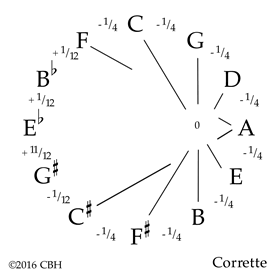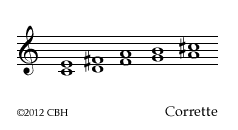Technical Library
TEMPERAMENTS XI: Corrette
Entire Contents Copyright © 2020 CBHTechnical LibraryTEMPERAMENTS XI: Corrette Entire Contents Copyright © 2020 CBH |

 WIKIMEDIA COMMONS / PUBLIC DOMAIN |
| Michel Corrette (1707–1795) |
French musician Michel Corrette (1707–1795) proposed a temperament in 1753 which reduced the huge wolf of Quarter-comma meantone by about half, while managing to retain five pure major thirds in useful keys. His discussion of tuning occupied three chapters near the end of his book with one of those wonderfully comprehensive eighteenth-century French titles: “LE MAITRE / DE CLAVECIN / Pour l’Accompagnement, / Méthode Théorique et Practique, / Qui conduit en très peu de tems à accompagner à livre ouvert, avec des / Leçons chantantes où les Accords sont notés pour faciliter l’Etude / des Commençans. Ouvrage utile à ceux qui veulent / parvenir à l’excelence de la Composition / Letout selon la Règle de l’Octave et / de la Basse Fondamentale”. Perhaps you really could judge a book by its cover in those days. A complete scan is available on IMSLP.
Corrette began his temperament from F, tuning eight Quarter-comma narrow fifths in a row, followed by a less-narrow fifth. Two other fifths are wide, and as always, the remaining G♯– E♭ wolf is not intentionally tuned: Corrette called it the ”deffaut de la Partition”.
(For several years, I enjoyed tuning this temperament from Asselin’s description with three fifths slightly wider than pure: Kayano regards those same three fifths as pure. Returning to his original text, though, Corrette wanted the C♯– G♯ fifth to be a “little more pure” than his eight Quarter-comma narrow fifths. I take that now to mean closer to pure, but still narrow rather than wide. We are really just splitting hairs about the placement of the G♯: A higher G♯ as I previously tuned will, of course, make a sudden difference between the A and E Major triads, but slightly improve the wolf. You choose.)
When you set the Corrette temperament by changing only three accidental notes of your usual Quarter-comma meantone, you can truly appreciate why it is one of a group of temperaments loosely termed “modified meantones”. Proceed as follows from the usual Quarter-comma recipe:
 1. Tune your b♭ a pure fifth below f', then lower
the b♭ until it has a very slight beat, much less than once
per second. The interval might be wide by perhaps a twelfth of a comma—the
same discrepancy as an equal-tempered fifth is narrow. There’s no
need to fuss or panic about this: Just so long as your interval is a tad wide,
you are probably just fine.
1. Tune your b♭ a pure fifth below f', then lower
the b♭ until it has a very slight beat, much less than once
per second. The interval might be wide by perhaps a twelfth of a comma—the
same discrepancy as an equal-tempered fifth is narrow. There’s no
need to fuss or panic about this: Just so long as your interval is a tad wide,
you are probably just fine.
2. Find your e♭ a pure fifth below b♭, then again expand the interval by lowering the e♭ until you hear an ever so slight beat.
3. All that remains is to determine your g♯ by tuning a pure fifth from c♯ but this time squeeze the interval until it has a slight beat: It must be narrow. Your c♯–g♯ should have a similar flavor to the fifth you have just tuned only a tone higher, e♭–b♭, although the latter is wide.
A wolf is still a wolf, though. Can we eliminate it? Let’s go one step further with modifying meantone and backtrack a little in time to look next at Rameau’s favorite temperament.
To tune Corrette from scratch, follow these steps:
1. Tune a' to your pitch source, and tune a an absolute pure octave below it.
2. Divide your pure f–a third into four quarter-comma narrow fifths, making f–c', g–d', c'–g' and d'–a' sound equally rough.
3. Find these notes in pure thirds from those you have already tuned: Tune b a pure third above g; your c♯' likewise pure above a; the e' above c'; and finally f♯' above d'.
4. Tune your b♭ a pure fifth below f', then lower the b♭ until it has a very slight beat, much less than once per second.
5. Find your e♭ a pure fifth below b♭, then again expand the interval by lowering the e♭ until you hear an ever so slight beat.
6. Determine your g♯ by tuning a pure fifth from c♯ but this time squeeze the interval until it has a slight beat: It must be narrow. Your c♯–g♯ should have a similar flavor to the fifth you have just tuned only a tone higher, e♭–b♭, although the latter is wide.
Further discussion
Anonymous [Kayano, Moxzan] Dodecagon — Chi-s akt temo Tokyo 2012, p23
Asselin, Pierre-Yves Musique et Tempérament Éditions Costallat, Paris 1985, p111
Zapulla, Robert Figured Bass Accompaniment in France Brepols, Turnhout 2000, p47
| Pitch nomenclature | |
| Harpsichord Tuning Process | |
| Tuning Bibliography | |
| Technical Library overview | |
| Harpsichords Australia Home Page |